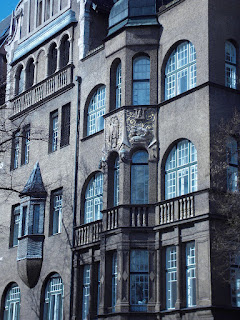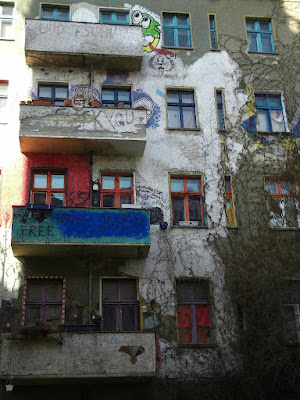 |
| Entrance with cafeteria |
What essential piece of wisdom did I take away from my visit to the Bauhaus-Archiv yesterday?
Roaming the exhibition halls, merely escorted by the soft English audio guide voices, I was pondering about life and learning and life long learning – and of course, if only briefly, about architecture and design.
The essential piece of wisdom I took with me was that wherever you go and whatever you do, it is good to look at things in a new, in a fresh, in a pure-minded way. Untainted, so to speak, as if human beings were able to ever look at anything in an "untainted" way ... ah, but let's leave this for now and just pretend we could.
For me, the essential of Bauhaus philosophy is to try and look at things in a different way. I will take that with me and hope I'll never forget to apply it to my daily life.
Roaming the exhibition halls, merely escorted by the soft English audio guide voices, I was pondering about life and learning and life long learning – and of course, if only briefly, about architecture and design.
The essential piece of wisdom I took with me was that wherever you go and whatever you do, it is good to look at things in a new, in a fresh, in a pure-minded way. Untainted, so to speak, as if human beings were able to ever look at anything in an "untainted" way ... ah, but let's leave this for now and just pretend we could.
For me, the essential of Bauhaus philosophy is to try and look at things in a different way. I will take that with me and hope I'll never forget to apply it to my daily life.
As for the museum: If you go there you absolutely will want to take an audio guide (it's included in the entrance fee). I thought it was great to be informed about so many details while looking at the pictures and design objects. By the way, it is strictly forbidden to take photographs inside the building!
The Bauhaus Archive Museum of Design houses an extensive collection documenting the history and impact of the Bauhaus movement.
The movement started out on April 1, 1919 in Weimar, then relocated to Dessau in 1925 and finally to Berlin in 1932 where it was pressured to close in April 1933 by the National Socialists.
The Nazis denounced the Bauhaus for its – what they called – "degenerate art" (the nazi term for modern art) and frowned upon its modernist style as un-German, probably influenced by Jews and on top of that a front for communists and social liberals.
Bauhaus
Bauhaus Museum Weimar
Bauhaus Movement Weimar
























































